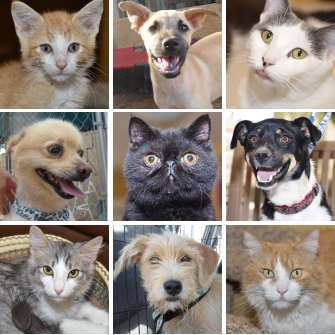Introducing a Cat to a Resident Dog
When introducing your dog to a new cat, you should make sure that your dog knows basic obedience.
You will need to have your dog under control when interacting with a new cat so he can learn which behaviors are appropriate and which ones are not. It is generally easier to introduce a kitten to a dog, but it isn’t necessary for a harmonious relationship. If you do bring home a kitten, follow the guidelines given below, but do not leave them together unsupervised until the kitten is at least four months old and able to defend himself if the need arises.
Introducing a new cat to a resident dog is similar to introducing cats to one another (as described in the Multi-Cat Household section).
Without letting them actually meet, you will want to start by giving the new cat a safe haven. Set him up in his own room and allow him to become comfortable. Once he is comfortable in the room let him explore the rest of the house for short periods each day while the dog is not there.
Cats’ personalities are directly related to how they perceive and experience their territory.
A cat who is comfortable and self-assured in his territory will be more confident and relaxed with new, potentially stressful situations. When the cat appears fairly relaxed in most areas of the house, let them meet. The best way to do this is to introduce them while the cat is up on a high surface unreachable by the dog (such as a counter or cat furniture), then bring the dog into the room on leash. Observe their interactions.
A dog that is showing overt aggression, such as snarling, growling, baring teeth, etc., will probably never accept a cat.
The cat is better off kept separated for the entire foster period. If all is reasonably calm so far, walk the dog around the room on leash. Let the dog go wherever he wants, but don’t let go of the leash in case the dog decides to chase the cat. On-leash interactions give the cat the opportunity to approach the dog if he chooses, or to find his own route of escape. During the first few meetings the cat and dog will probably not interact face to face.
A dog is a predatory animal. It is a natural instinct for a dog to want to chase a cat. Assume that the dog will chase the cat—so that you are prepared. Do not ever let the dog intimidate the cat by barking or chasing. Use a lead and collar and give a quick, sideways tug each time the dog acts inappropriately to let him know these behaviors are unacceptable.
On the other hand, if the cat bops the dog on the nose as a warning, that is a good sign and should not be discouraged. When they set up boundaries between themselves, they are beginning to establish a working relationship. Let them interact with the dog on leash for about one half hour, then return the cat back to his safe haven. Increase the amount of time they are together a little each visit.
It is important to be patient and encouraging in their interactions.
If you are relaxed, they too will be more at ease. Always praise friendly behavior profusely. Don’t try to rush the introduction or force them to interact more than either of them are willing. Pressing them to accept each other will only slow down the adjustment process. You should use your best judgment as to when they can begin supervised sessions with the dog off-leash.




